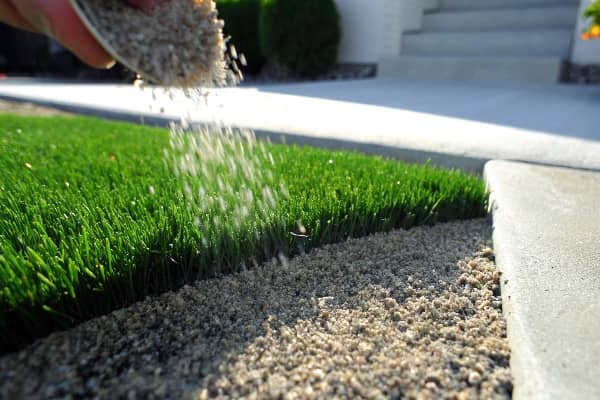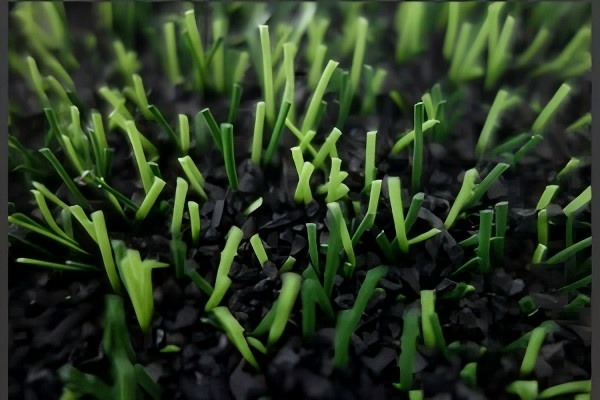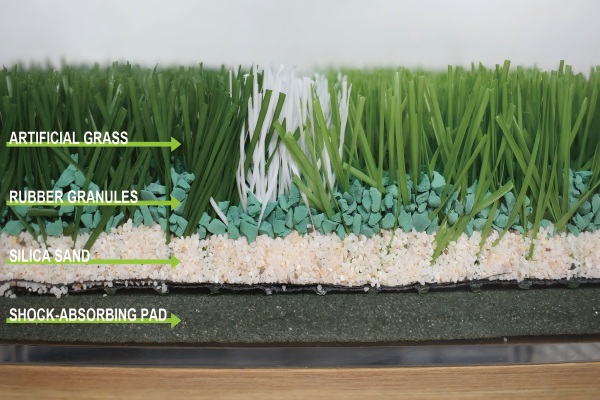Your new artificial grass looks amazing, but you worry it will get flat and worn. It gets hot in the sun, and the blades don’t stand up straight.
Yes, most artificial grass installed in a yard needs infill. Infill is a granular material spread between the grass blades. It helps the fibers stand upright, protects the backing from UV damage, weighs the turf down, and provides a more natural, cushioned feel underfoot.

Deciding to use infill is the first and most important step. But many of my clients find the next part confusing. There are different types of infill, and choosing the wrong one can completely change the performance and lifespan of your turf. To get the stable quality and long-term success we promise at QH Grass, you need to understand your options. Let’s break down what infill does and which type is right for your project.
Why Use Sand Infill for Artificial Turf (And When Should You Avoid It)?
You need an affordable infill, but you’re worried sand will feel too hard or trap dirt. Choosing the wrong infill can lead to a lawn that underperforms and doesn’t last.
Sand is a popular infill because it adds weight, supports the grass fibers, and protects the backing from sun damage at a low cost. However, you should avoid basic sand in pet areas due to odor retention and in playgrounds where a softer, non-abrasive material is safer.

In my early days as a turf engineer, I saw firsthand how critical infill is. It’s not just "sand on grass." It serves several vital functions that I always explain to my customers. Understanding these functions helps you see why it’s a necessary part of the system.
The Main Jobs of Sand Infill
- It Adds Weight (Ballast): Artificial turf is essentially a heavy carpet. Without weight holding it down, it can expand, contract, and wrinkle with temperature changes. I once had a client who tried to save money by skipping infill on a large yard project. After one hot summer, the turf looked like a wavy blanket. We had to go back and add sand infill to stretch it out and secure it properly. Sand acts as ballast, holding the turf securely in place.
- It Supports the Fibers: The grass blades on your turf are designed to stand up. Infill provides the necessary structural support at the base of each blade, keeping them upright and resilient. This makes the lawn look fuller and more natural, and it helps the fibers bounce back after being walked on.
- It Protects the Backing: The primary backing of the turf is what holds everything together. Constant exposure to direct sunlight can make this material brittle over time. Infill covers the backing, creating a protective barrier against UV radiation and extending the life of your entire turf system.
When Sand Isn’t the Best Choice
- If you have pets: Standard sand can absorb and trap moisture from pet urine. Over time, this creates a breeding ground for bacteria and can lead to very unpleasant odors that are hard to remove.
- For children’s play areas: While it’s generally safe, some silica sand can be slightly abrasive. For areas where children will be playing and potentially falling, a softer, rounded infill is a much better and safer option.
Silica Sand vs. Envirofill: Which Infill Should You Choose for Your Artificial Grass Project?
You’re stuck between two popular infills. Silica sand is cheap, but Envirofill claims to be better for pets and kids. Making the wrong choice could cost you money or performance.
For basic landscaping on a tight budget, silica sand is a reliable choice. For projects involving pets, children, or high use, Envirofill is the superior option. Its anti-microbial coating and cooling properties justify the higher initial cost by providing a cleaner, safer, and longer-lasting lawn.

Choosing between these two is a common puzzle for my clients. They see the price difference and wonder if the extra cost for a premium infill like Envirofill is worth it. From my experience helping customers grow their businesses, the answer depends entirely on the specific use of the turf. Let’s look at them side-by-side.
What Are They Made Of?
- Silica Sand: This is a natural product made from quarried quartz that has been washed and tumbled. It’s the most basic and affordable infill. It does its job well for general-purpose lawns, and for years, it was the industry standard for almost every application.
- Envirofill: This is also a sand product, but with a major upgrade. It consists of rounded sand granules coated with a layer of acrylic. This coating is the key to its advanced performance. It makes the infill non-absorbent, anti-microbial, and less abrasive.
Head-to-Head Comparison
I created this table to help a client in Mexico decide on the infill for a series of residential projects he was bidding on. He needed to balance quality with a competitive price, and this breakdown made the choice clear for each unique yard.
| Feature | Silica Sand | Envirofill |
|---|---|---|
| Cost | Low | High |
| Pet Use | Poor (absorbs moisture and traps odors) | Excellent (anti-microbial coating stops odors) |
| Child Safety | Fair (can be abrasive) | Excellent (rounded particles are softer) |
| Heat | High (absorbs and retains heat) | Low (coating helps keep the surface cooler) |
| Durability | Good (but can compact over time) | Excellent (rounded shape prevents compaction) |
| Cleanliness | Fair (can create dust) | Excellent (coating reduces dust and stays clean) |
Ultimately, the best choice is the one that meets the demands of the space. If you’re installing a simple front lawn that doesn’t get much heavy traffic, silica sand is a perfectly good, budget-friendly option. But if the turf is for a backyard with dogs and kids, spending more on Envirofill will prevent major headaches with smell and safety down the road.
Conclusion
Infill is not an optional add-on; it is essential for the performance and longevity of your artificial grass. Choosing wisely between options ensures your turf system delivers success for years.
_画板-1.png)
_画板-1.png)